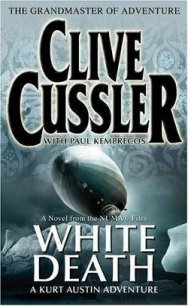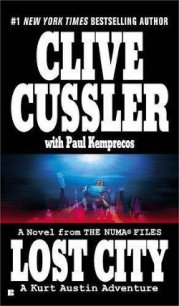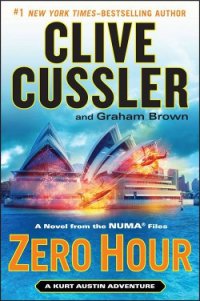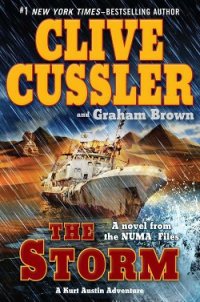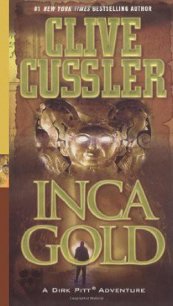The Navigator - Cussler Clive (читаем книги онлайн бесплатно полностью .TXT) 📗
Ridley’s men slipped their weapons off their shoulders, dropped them onto the deck, and threw their hands in the air, leaving the man in the water to fend for himself. Ridley slowly brought his hands up.
Carina was being helped to her feet by Captain Mustapha. Austin was distracted by the sight of blood streaming from her mouth. In the meantime, Ridley had brought his hands together over his head, pulled the pin, and had an arm back ready to toss the grenade at the oncoming vehicle.
Austin’s eyes went back to Ridley and his finger tightened on the trigger. He hesitated, fearing that Ridley might drop the grenade to the deck. Captain Mustapha had also seen Ridley arm the grenade. As Ridley brought his arm back in a throwing position, the captain snatched a boat hook from a rack and brought the heavy wooden handle down on Ridley’s wrist. The grenade flew from his fingers, hit the rail, and rolled onto the deck.
Reacting with lightning speed, Mustapha dove on the grenade and flipped it over the side.
Ridley roared with pain and rage. He fumbled at his belt with his left hand for another grenade. Austin’s gun stuttered and laced Ridley’s chest with bullet holes. Ridley pitched over backward into the water as the grenade exploded and sent up a geyser that spattered onto the deck.
Austin swung the gun barrel toward the other two men.
“Jump,” he ordered.
He let off a fusillade at the awning. Shreds of canvas rained down like confetti. The men jumped over the side and joined the crewman already in the water. Austin triggered another burst that ripped into the water within inches of the swimmers.
Austin watched the sorry trio swim to land, then scramble onto shore and disappear into the woods. He put more holes in the listing speedboat and then turned his attention to Carina.
Mustapha wrapped some ice cubes in a dish towel and she held the improvised compress against her head. Austin saw that she was not seriously hurt and handed the gun to Mustapha, with instructions to shoot first and ask questions later.
Zavala brought the Subvette alongside the motor cruiser and Austin climbed aboard. The vehicle slipped below the surface and descended to the launch platform. Austin swam to the control console, and Zavala brought the vehicle down on the platform and the clamps locked it in place. Austin activated the pumps to expel water from the pontoons.
The launch platform surfaced near the motor cruiser, and it sat at a steep angle in the water because of the weight of the statue at the stern. Mustapha handed Carina the gun and moved his boat closer to the LRT platform. He threw a towline to Austin and Zavala. Then they slipped into the water and breaststroked to the boat ladder.
Back on board, Zavala peeled out of his wet suit, and glanced toward the wooded shore. “How did those guys find us way out here?”
Austin picked up his shirt and slipped the satellite phone from the pocket. “They may have zeroed in on the phone signal. Let’s not take any chances.”
He winged the phone as far as he could and watched it splash into the water. Then he thanked Mustapha for his quick-witted work with the boat hook and apologized for putting him and his boat in jeopardy and ruining his awning. The Turk took it in good spirits, but he wondered if he could call it a day and get paid. Austin peeled off enough Turkish lira to choke a horse.
“One more favor. We need to go somewhere we can be undisturbed,” he said.
“No problem.” The captain tucked the bills into his pocket. “There’s a place a few miles from here.”
LESS THAN half an hour later, Mustapha steered his boat into a quiet cove and anchored behind an outcropping of land. Mustapha said that local mariners avoided the inlet because the rocks hidden under the surface at the entrance made it tricky to navigate.
Zavala sat in the bow with the machine pistol resting in his lap. Carina gathered up a bag holding art supplies she had bought the day before and got into the skiff with Austin. He rowed to the launch platform, and they climbed aboard.
Carina leaned over the statue. “I feel guilty disturbing his sleep after all these years,” she said with undisguised tenderness.
“He’s probably glad to have a beautiful lady keep him company,” Austin said. “Look at his smiling face.”
Carina brushed away the dried marine vegetation clinging to the statue’s mouth. The face was that of a young bearded man with a strong nose and chin. Like the original statue, he wore a neck pendant engraved with a horse head and palm tree, a kilt around his waist, and sandals on his feet. The lack of arms gave him the grotesque aspect of a disaster victim.
Carina opened her bag, pulled out two sponges, and handed one to Austin. Working together, they cleaned every square inch of bronze. Carina laid out a brush, a square of cheesecloth, and a jar of liquid latex. She applied multiple layers of latex to the statue’s face, pendant, and other sections, then stiffened the layers with cheesecloth. The dried layers were peeled off, labeled with a marking pen, and carefully placed in the bag.
“It’s done,” she said, peeling off the final mold.
“What about the cat?” Austin said. “He was part of the crew.”
“Absolutely right,” Carina said with a smile. She applied the latex process to the side and half-turned face of the cat.
After the cast hardened, she removed it. Her work was done, but she was reluctant to leave.
“What should we do with him?” she said.
“We can’t bring the statue back,” Austin said. “It’s too heavy to move without specialized equipment, and transporting it overland would be a major problem. Someone is bound to see us. The Turkish authorities do not look kindly on foreigners who steal the country’s antiquities.”
Carina had a sad look in her eyes. She gave the statue a kiss on both cheeks. She patted the bronze forehead and got back into the skiff. Back on the boat, Austin asked Mustapha the depth of the water in the cove. The Turk said it was around fifty to sixty feet deep.
Austin and Zavala rowed back to the launch platform and, bracing their backs, shoved the statue with their feet. The statue teetered on the edge. One final push sent it over the side. The Navigator plunged into the depths, as if eager to return to the sea, and quickly disappeared from sight.
Chapter 30
THOUSANDS OF MILES FROM Turkish waters, the Navigator’s twin rotated slowly on a circular pedestal about a foot high, shimmering like an angry god under the battery of lights that bathed its bronze skin in a polarized glow.
A ghostly white, three-dimensional X-ray image of the Navigator pivoted on a large wall screen. Arrays of electronic probes surrounded the ancient statue.
Three men sat in leather chairs facing the screen. Baltazar was enthroned in the center. At his right was Dr. Morris Gray, an expert in the use of computed tomography. On Baltazar’s left was Dr. John Defoe, an authority in Phoenician history and art. Both scientists had been absorbed into Baltazar’s corporate empire with the expectation that the statue eventually would be found.
Gray aimed his laser pointer at the screen. “The X-ray technique we’re using here is similar to the CT scans employed in hospitals,” he said. “We take photographic slices of the object. The computer renders the photos into a 3-D image.”
Baltazar was slouched in his chair, his thick fingers entwined, his gaze fixed on the pale image projected against a dark blue background. He had waited for this moment for years.
“And what does your magic lantern tell us, Dr. Gray?” he rumbled.
Gray smiled slightly. He moved the laser’s red dot to a display panel, one of several that ran from top to bottom along the right side of the monitor.
“Each box shows information taken from the probes. This displays the statue’s metal composition. The bronze is the standard ninety percent copper and ten percent tin. The other boxes deal with thickness, tensile strength, as well as information that’s not pertinent.”
